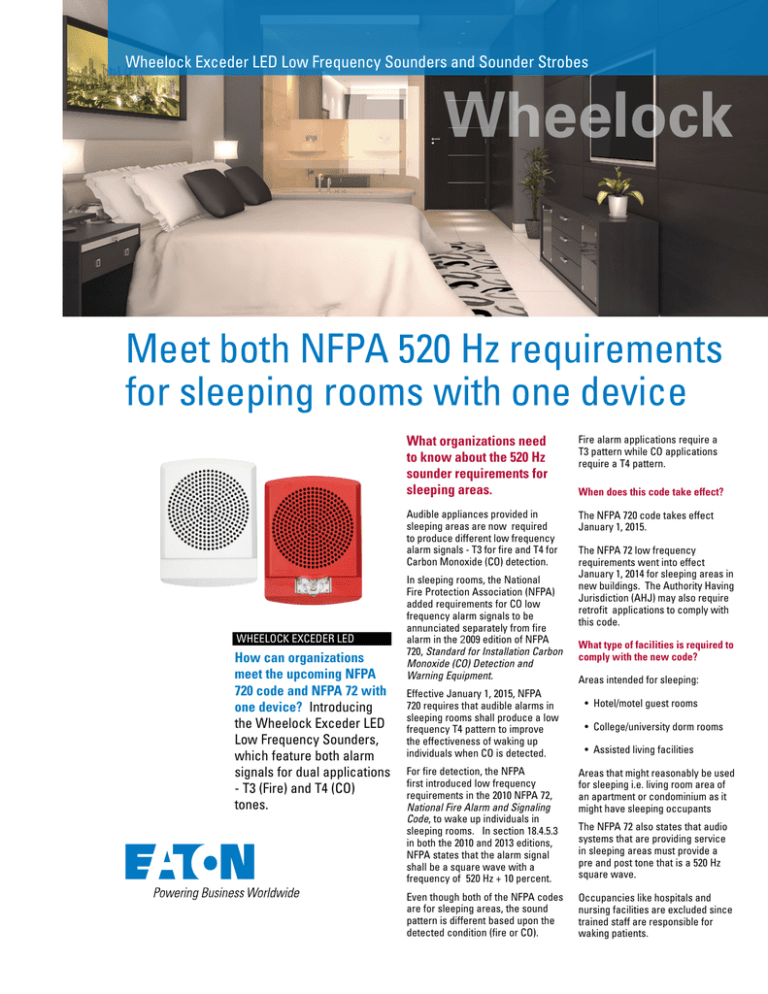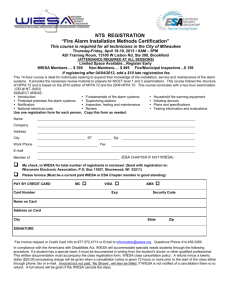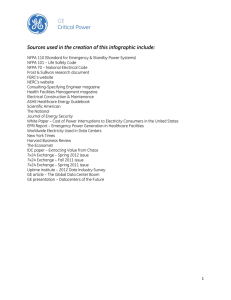
Wheelock Exceder LED Low Frequency Sounders and Sounder Strobes
Wheelock
Meet both NFPA 520 Hz requirements
for sleeping rooms with one device
Wheelock exceder LEd
How can organizations
meet the upcoming NFPA
720 code and NFPA 72 with
one device? Introducing
the Wheelock Exceder LED
Low Frequency Sounders,
which feature both alarm
signals for dual applications
- T3 (Fire) and T4 (CO)
tones.
What organizations need
to know about the 520 Hz
sounder requirements for
sleeping areas.
Fire alarm applications require a
T3 pattern while CO applications
require a T4 pattern.
Audible appliances provided in
sleeping areas are now required
to produce different low frequency
alarm signals - T3 for fire and T4 for
Carbon Monoxide (CO) detection.
The NFPA 720 code takes effect
January 1, 2015.
In sleeping rooms, the National
Fire Protection Association (NFPA)
added requirements for CO low
frequency alarm signals to be
annunciated separately from fire
alarm in the 2009 edition of NFPA
720, Standard for Installation Carbon
Monoxide (CO) Detection and
Warning Equipment.
Effective January 1, 2015, NFPA
720 requires that audible alarms in
sleeping rooms shall produce a low
frequency T4 pattern to improve
the effectiveness of waking up
individuals when CO is detected.
When does this code take effect?
The NFPA 72 low frequency
requirements went into effect
January 1, 2014 for sleeping areas in
new buildings. The Authority Having
Jurisdiction (AHJ) may also require
retrofit applications to comply with
this code.
What type of facilities is required to
comply with the new code?
Areas intended for sleeping:
• Hotel/motel guest rooms
• College/university dorm rooms
• Assisted living facilities
For fire detection, the NFPA
first introduced low frequency
requirements in the 2010 NFPA 72,
National Fire Alarm and Signaling
Code, to wake up individuals in
sleeping rooms. In section 18.4.5.3
in both the 2010 and 2013 editions,
NFPA states that the alarm signal
shall be a square wave with a
frequency of 520 Hz + 10 percent.
Areas that might reasonably be used
for sleeping i.e. living room area of
an apartment or condominium as it
might have sleeping occupants
Even though both of the NFPA codes
are for sleeping areas, the sound
pattern is different based upon the
detected condition (fire or CO).
Occupancies like hospitals and
nursing facilities are excluded since
trained staff are responsible for
waking patients.
The NFPA 72 also states that audio
systems that are providing service
in sleeping areas must provide a
pre and post tone that is a 520 Hz
square wave.
Background
The solution
In 2006, The Fire Protection and
Research Foundation (FPRF)
was awarded a Fire Prevention
and Safety Grant by the US
Fire Administration to study
the effectiveness of alarms for
emergency notification of high
risk groups. As a result, the FPRF
found that a “square wave sound
with a fundamental frequency in
the lower ranges (i.e. 520 Hz) to be
more effective than the current high
pitched smoke alarm signal across a
range of populations (children, older
adults, sober young adults, alcohol
impaired young adults and adults
who are hard of hearing).”
Introducing the Wheelock Exceder
LED Low Frequency Sounder
Strobes and Sounders
In the 2009 edition of NFPA 720, the
code states that audible appliances
in sleeping areas are required to
produce a low frequency alarm
signal (T4) for CO detection. It also
requires that audible (CO) alarm
must be annunciated separately
from a fire alarm, and audible
and visual devices for CO cannot
reference “Fire” on the face of the
device. Combination units can only
indicate “Fire” on the fire indicating
device. Prior to 2009, NFPA 720 only
referenced 1 and 2 family dwellings.
In the 2012 edition, the code was
expanded to include sleeping areas
in commercial spaces. This goes
into effect January 1, 2015.
The 2010 edition of NFPA 72 requires
that sleeping rooms must have low
frequency audible and high intensity
strobes for fire notification. For
audible messages, the preamble
must be a 520 Hz sounder with T3
pattern.
In typical applications in sleeping
areas, a FACP is monitoring both
CO detectors and smoke detectors
and must sound a distinctive 520 Hz
signal based upon the event (T3 for
Fire, T4 for CO), which has merged
the requirement for 520 Hz sounders
for the FACP providers.
NFPA 72 code went into effect
January 1, 2014 for those states that
have adopted the 2010 version of
NFPA 72.
As the industry’s foremost developer
in advanced technological
solutions for fire, life safety and
mass notification, Eaton’s Cooper
Notification business has developed
a single device to meet both low
frequency sounder codes for
sleeping rooms - NFPA 72 for fire
alarm and NFPA 720 for CO alarm.
The Exceder LED Low Frequency
Sounder Strobes and Sounders
feature multiple 520 Hz modes of
operation.
• T3 (fire)
• T4 (CO)
• Continuous (coded)
• T3/T4 Sync Control
The 520 tone is generated within
the appliance itself. When the
selector switch is set for T3 or
T4, the sound pattern is also
generated within the appliance.
When the selection switch is set to
continuous, the product is listed for
coded operations. The T3/T4 pattern
or other pattern must be generated
by the FACP according to the alarm
condition sensed by the panel (fire
or CO alarm).
When the device is set to T3/T4, the
appliance can switch from T3 to T4
based upon the condition sensed
by the FACP and passed to the
Wheelock DSM Sync module.
This provides a simple retrofit for
sleeping rooms. The Exceder LED
Low Frequency Sounders and
Sounder Strobes can replace an
organization’s existing appliances
with a single/dual function device,
using the same single pair of wires
that are currently installed.
The new Low Frequency Sounders
are the first product in the industry
to be listed to the audibility
requirements of UL 2034 and UL
2075.
Like the entire Wheelock Exceder
LED product line, the Low Frequency
Sounder Strobes will utilize Light
Emitting Diode (LED) as the light
source—a breakthrough optical
design, resulting in best-in-class
efficiency that enables material and
system cost savings, allowing for a
greater number of appliances on the
notification appliance circuit and
fewer power supplies. All LLFHS
strobe models feature a 110 candela
setting.
Both the LLFHS and LLFHN
models will also feature one of the
industry’s smallest footprints and a
sleek, modern, low-profile design.
Exceder LED Sounder Strobes
may be synchronized when used
in conjunction with the DSM
Sync Modules, Wheelock Power
Supplies or other manufacturers
panels incorporating the Wheelock
Patented Sync Protocol. Wheelock
synchronized strobes offer an
easy way to comply with ADA
recommendations concerning
photosensitive epilepsy.
The Exceder LED Low Frequency
Sounders and Sounder Strobes
are UL Listed for indoor use under
Standard 1971 and 464 and ULC
Listed under S525 and S526.
Eaton
1000 Eaton Boulevard
Cleveland, OH 44122
United States
Eaton.com
Eaton
Cooper Notification Solutions
273 Branchport Avenue
Long Branch, NJ 07740
www.coopernotification.com
© 2014 Eaton
All Rights Reserved
Printed in USA
Publication No. PA001001EN
October 2014
Eaton is a registered trademark.
All other trademarks are property
of their respective owners.
Wheelock Exceder LED
Organizations can now
meet both sleeping room
codes - NFPA 72 and
NFPA 720 with a single
device. Introducing the
Wheelock Exceder LED
Low Frequency Sounder
Strobes and Sounders for
dual applications - T3 (Fire)
and T4 (CO) tones.




